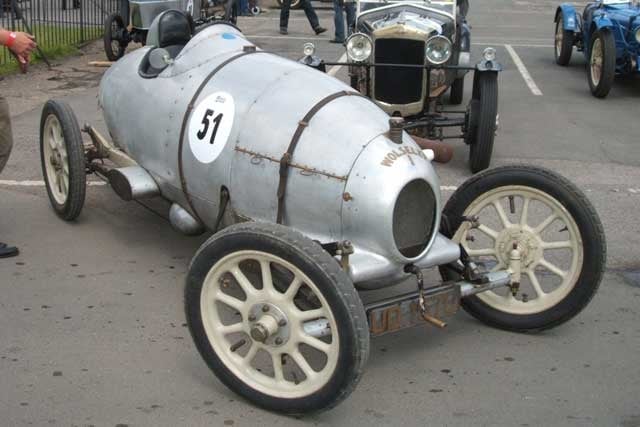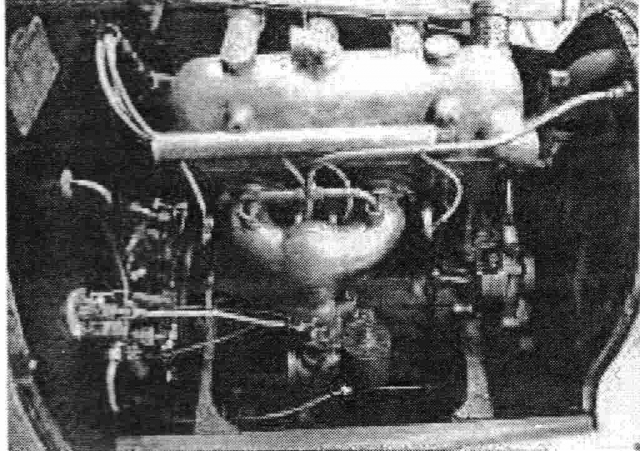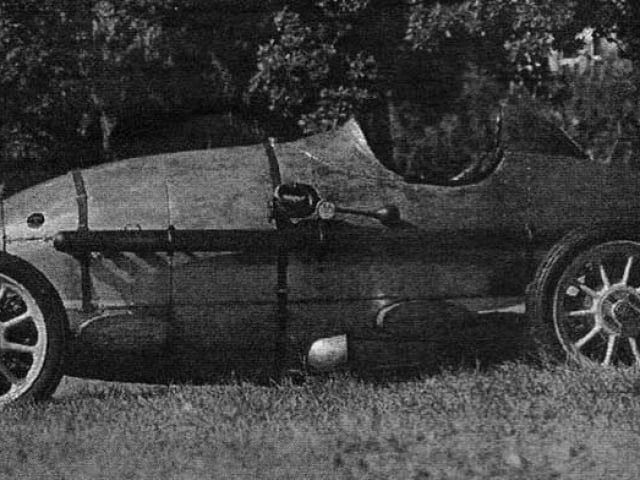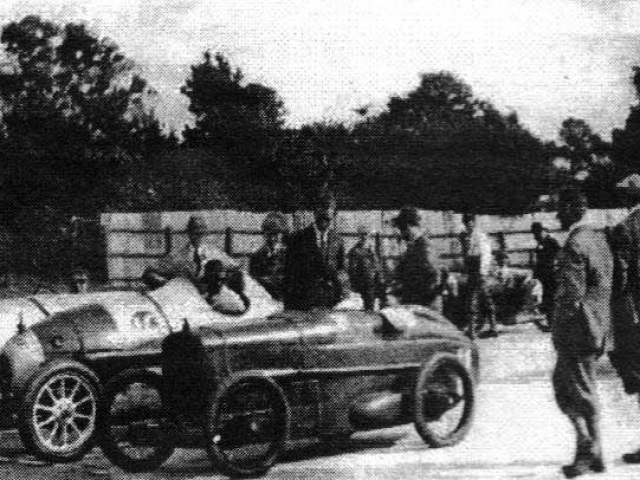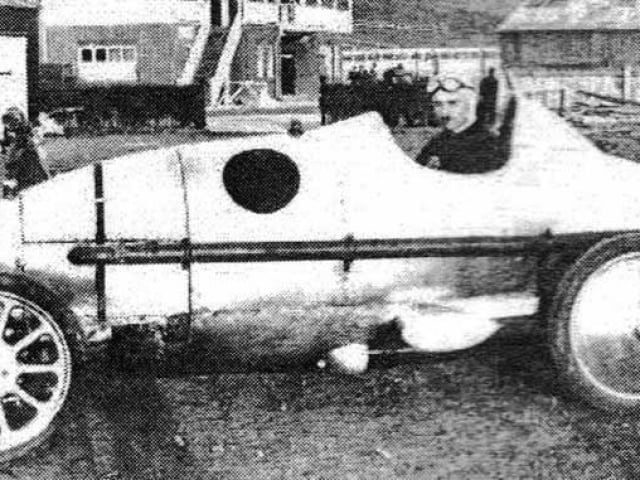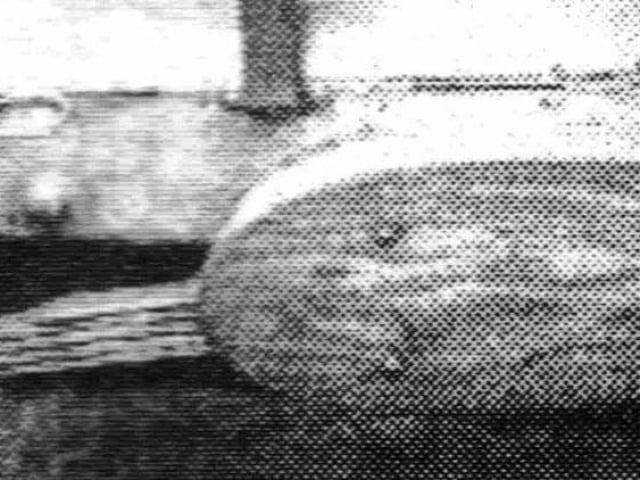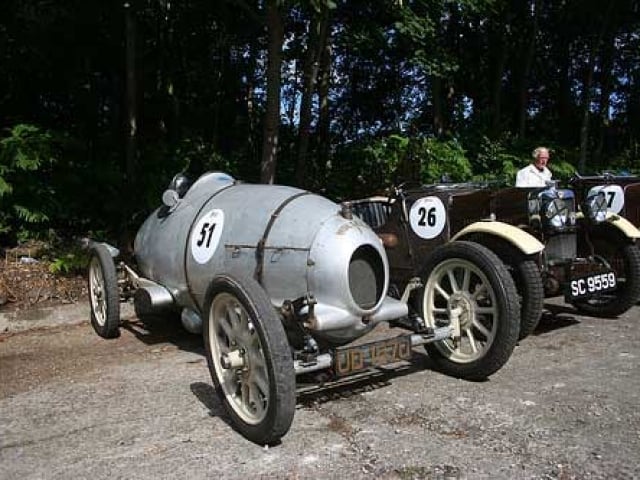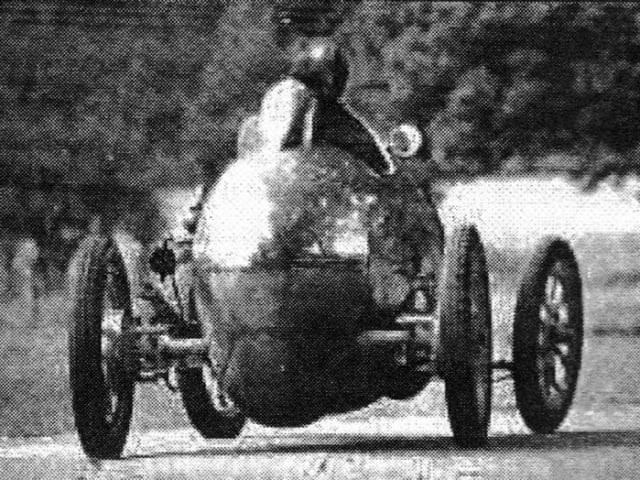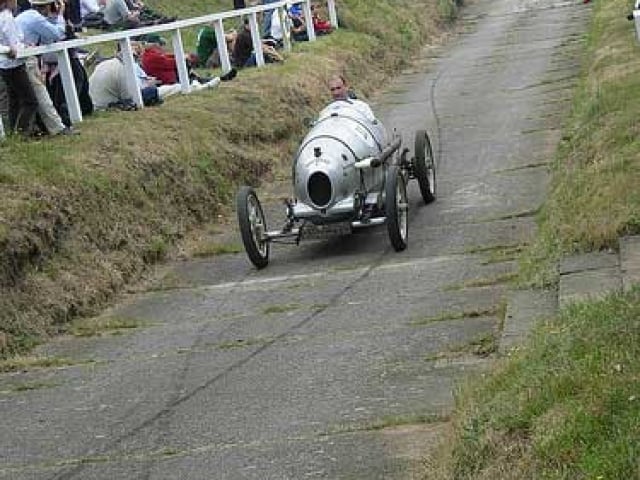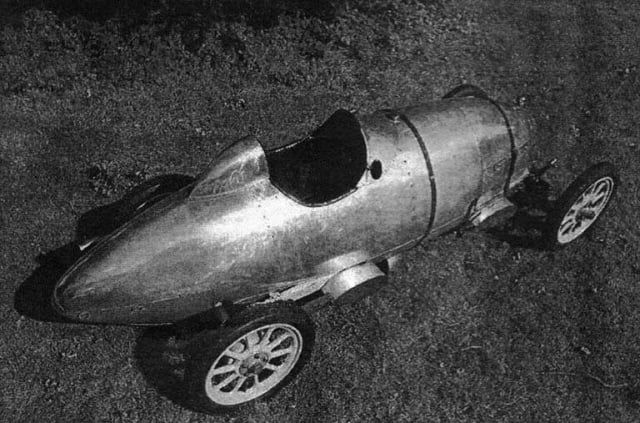The Silver Bullet
By Norman Painting
Brooklands inspired some very unusual looking cars, especially in its twenties heyday. One of the oddest looking of some very bizarre machines was the Wolseley “Moth”. Funnily enough, this super-streamlined single-seater racing car, looking a bit like a discarded aircraft drop-tank on wheels, had very humble origins.
Just after the First World War, the Wolseley concern had to decide for which type of market it was going to cater – luxury models for munitions profiteers or small cars for demobbed officers and other servicemen. They chose to sit on the fence and produced for both, with a new line of light cars being devised, which used overhead camshafts, a very daring move for the conservative British industry.
There can be little doubt that the firm’s extensive involvement with the Wolseley Viper V8 aero-engine, and the Hispano-Suiza unit from which it was derived, influenced the decision to use overhead cams. They were operated by a complicated arrangement of a chain-driven jack-shaft from the front of the crankshaft. which then drove another vertical shaft and the camshaft by means of bevel gears.
Little Recommendation
Apart from the ohc valve actuation these little Wolseleys, the Ten and 15hp, had little to recommend them. The engine drove through a rear-mounted three-speed gearbox, there was a worm drive back end, and springing of the beam axles was by quarter elliptics all round. The Ten didn’t make it into production until February 1921, by which time the press had tested one and found it to be slow. Very slow in fact. A top speed of 40mph was poor for a small car costing £545, particularly when cheaper cars were capable of higher speeds.
The Moth’ racer was actually born in an attempt to boost the cars pedestrian image, to prove that standard Wolseley components could be raced. The Wolseley management became involved with Captain A.G. Miller, who had run one of the 1914 GP Opels at Brooklands in 192~ Just to prove that the car Miller was given to race prepare was a standard Wolseley Ten, factory records show that the Moth’s chassis was commandeered by the experimental department before it could go to its intended owner, and loaned to Miller on September 20, 192Engine-wise, little was done to prepare the car.
Higher compression pistons were fitted, while Ysin was taken off the cylinder head, which was gas flowed and fitted with a special straight-through exhaust system. There was a different cam profile, and a Zeroth triple diffuser carburettor was also used. Capacity, at 1261 cc, was unaltered, and initially, the engine retained splash lubrication – however, the three subsequent 1 OHP racing engines were all modified to give full pressure lubrication. The chassis remained essentially as the Ten, apart from modified steering (the Moth used a drop arm and drag link),- and a higher back axle ratio: for Brooklands track use, a 3:7:1 ratio was used, although apparently a 3:1 ratio was made. Gearbox ratios were as the standard ten, and there were no major modifications to the braking or frame. What marked the machine out was the bodywork, though. Reputedly it was designed in a wind tunnel (Wolseley was owned the Vickers the aircraft manufacturers), although that is somewhat open to debate, and may just have been publicity ‘hype’.
The bodywork looked stunning, the effect heightened by the polished aluminum finish. At the front there was a small oval cowl encircling the radiator, with the bonnet sweeping up to a high cockpit, enclosing the driver up to his shoulders. There was a pointed tail, high headrest, and wing section fairings everywhere -on the front axle, over the spring anchorages and brake gear. The whole car was beautifully finished – it ought to have been with I the company’s aviation background — with rivets and fittings made out of nickel silver, and in 1921 form the car was equipped with rear-wheel discs. The car was earned theMoth’ for a less than obvious reason – according to Bill Buddy, Editor of Motor Sport and well known Bro kiands authority, Miller was a great patron of the theatre and leading West End restaurants and clubs, and named tie car after a troupe of chorus girls. What could be simpler and less appropriate?
It did not take long for the Moth to get into action, the car appearing at the last BARC race meeting of 1921. It wasn’t a particularly auspicious debut, as it was rammed by an errant Bugatti in its first handicap, although Miller fitted a front axle from a standard Ten and made it to the start of the 75m ph Long Handicap only to retire.
Later that year, in November, the car came out again and took eleven new Light Car records, which included averaging 82.82m ph for four hours. Wolseley made capital out of those successes, although the following May, Miller and co-drivers C.F. Temple and (IA. Vandervell (of Vandervell bearings fame) made The Motor’s front cover after taking the first-ever British `Double-Twelve’ record, and in a Light Car to boot. The average speed for the 1465.6 miles was 61.06 ph, despite the scuttle fuel tank coming adrift, and two hours being lost when a big end was replaced.
New Records
As a result of the Brooklands successes, Wolseley marketed a sports Ten, which was catalogued with artillery wheels, Hartford shock absorbers, the extended oil filler evolved for the racer, an outside exhaust system and 65mph capability.
The following season saw the Double-12 record improved on by The Moth after AC and Spyker had overhauled the original mark =- this time the Moth covered 1922 miles, 1620 yards at an average speed of 80.1 mph, very impressive fora 1261 cc car in 1922.
The first Moth, which became known as ‘Moth I’ in 1923, never had a particularly successful time in Brooklands races, with one victory, a 50-mile handicap, to its name, when driven by Dudley Froy. The second ear, built for millionaire Woolf Barnato, was delivered in 1923 — he had ordered one of the Brooklands Speed Models, and had at bodied in the same style as the Moth — it was known as ‘Moth II’. The car cost 600 pounds and was paid for one week after delivery.
The man obviously had money. In a two year spell, Barnato picked up three firsts, four seconds, and three thirds, making this the more successful of the two cars. Miller’s involvement with the ‘factory-run’ Moth came to an end when the Wolseley M.D. responsible for the Moth experiment, Mr McCormack, resigned. Barnato continued to race throughout 1924. Miller kept Moth I until 1928 when it was sold to a Mr Cain, who ran it on the road as a single-seater (!), but the other car was eventually borrowed back by Miller in 1929, and he managed to win the Cornwall Junior Short Handicap at Brooklands in 1930, but then, after being hawked around the trade and resuscitated by Messrs P. Thompson and A. Lyon Clarke, it seems to have disappeared.
Moth I’s history is somewhat better known, mainly as a result of John End’s painstaking research into the vehicle. He is the man responsible for the lovely Moth replica which is a familiar sight at vintage meetings and on the roads around the Ascot area!
The story of the Moth after 1928, when Sidney Cain bought it, is that he ran it on the road until 1935when it was converted into a two-seater in order to sell it. Nobody at the time wanted an old single-seater, so the conversion was necessary to get rid of it. It was kept by the family firm of Bell Street Motors in Henley, who proceeded to park it in a used car lot around the back of ‘The Three Tuns’ pub in Henley. Bill Boddy and Denis Jenkinson had been looking for the car according to John, at around this time, but never realized where it was kept! After its sojourn in Henley, it was sold to Deacons Garage in Dorchester, who paid the princely sum of £37 IOs for it. It then went to ground, and it took quite some time for it, or at least some of its parts, to re-emerge.
Spares Source
John’s involvement with the Moth started after he had bought the remains of a 1925 Wolseley saloon as a restoration project. “At the time, I needed some hub-caps and I heard of this chassis lying in Cornwall in 1970 – it was obviously different from my saloon, but it was a good source of spare parts. Next time I cannibalized it, I took the rocker cover and head, carried them home, and realized that as the asking price for the whole lot was £25, I may as well purchase it. I blithely made the trip westwards only to find the car had disappeared, sold to a bloke up the road. Eventually, I got in contact with the owner and spent a few days going down to Cornwall, taking the car apart and transporting it home in stages.
“I then left the bits in the back yard, while I got on with the saloon. To cut a long story short, I became involved with Cohn Thomas, who had decided to build a replica of the firm’s 200-Mile Race car. I did some research about his car, and in doing so, by chance, some technical data sheets on the Wolseley racers came in the post from Australia – and the engine number for the Moth was the same, 30976, as the unit in the back yard! The rear axle had a sports ratio fitted too.” Quite why the Cornish car had been fitted with the Moth engine is a mystery.
The detective story now started in earnest. John decided to rejuvenate the Moth, although he says that he would have preferred to build a 200-Mile Race replica. Prior to the restoration, John had to look around for Wolseley Ten parts, through contemporary magazines for details and also traced Mr Cain, whose memory was “amazing considering he was in his 70’s and had not seen the car since the mid-thirties”. He provided many detailed sketches of various parts, which were a great help.
John’s real scoop was when he managed to get hold of some of the photo albums which were lying dormant at Cowley. “I built the body and radiator from slides that I had made from these Wolseley albums: I took quarter-scale drawings from projecting these slides up on the garage wall. All this work came to naught when I managed to stumble on all the Wolseley works drawings at Cowley – there was a radiator plan, patterns for the back axle and camshafts, everything. I had the start the body again after finding the original plans!” John also made new camshafts and later on acquired another Moth engine, this being one of the pressure-fed engines which was used in the Becke Power Plus special before the car took three years to build – among other things, a new body and radiator had to be constructed. Mechanical parts were Wolseley Ten, the dials had new faces made, and John produced a new worm wheel for the back axle to the original patterns. About the only thing he didn’t do was trim the car, which was done by a friend. As you can see, the finished result which first came out in 1978 is a work of art, a real tribute to John’s craftsmanship. All the brightwork is in nickel silver, and it looks gorgeous. He’s after al hp engine for his next project now.
As with the car’s debut at Brooklands in 1921, John suffered a minor collision when his car came out for a Riley Register organised day of jollities at the historic track. Since them, the car has been used extensively and has made the odd competition appearance in VSCC events, including the outings at Sheisley Walsh, Prescott and the annual Colerne sprint, where the car has covered the standing quarter-mile at a speed of 81.3 mph.
The car is also used regularly on the road. John made wings and initially fitted cycle lights, although these have been replaced. ‘”The local Police Sergeant called the cycle lights `bobby dodgers’, and I suppose he is right,” says John.
He kindly let me drive the car at Coleme. He said I would need a lot of space for it on first acquaintance because the brakes aren’t too clever.
The first problem with a Wolseley Moth is getting into it. It’s quite a long way up to that lovely leather upholstered seat, and you have to lever your way into the car. Getting stuck half way is apparently quite possible. Once installed, it is very snug. The steering wheel is very close to the driver, and contributing to an odd driving position is the fact that your legs are nearly straight out, flat to the floor. Ahead of you, there is a high scuttle — no aero screen on this one – and the wheels are exposed, making the car easy to place. As for the depth of the cockpit — well, you feel like a tank commander must do, with the head alone in the airstream, shoulders buried in the cockpit.
The pedals are in the standard English position – no hints of fancy centre throttles and there are only four gauges in front of you, for speed, revs, temperature and oil pressure.
Tricky Getaway
The engine has a fairly undistinguished, if rorty note. The clutch is of the ‘in-or-out’ variety, and allied to that high Brooklands back axle ratio makes getting away from a standstill quite tricky. But once into its stride, the car goes really well — John regularly sees over 70mph on the road. The gear change itself is sure and positive — there are only three gears, so acceleration is a little tardy.
At around 50mph, you feel like you are flying – the combination of engine noise and the air rushing over that high scuttle into your face is pure exhilaration. If you are a masochist, then the ride’s exhilarating, too, but then I’m not and I can’t use the words that really do sum up the ride of the Moth in print.. Quite how Alastair Miller and the others who drove the cars survived over the Brooklands bumps, I don’t know. They must have been made of sterner stuff.
Handling is entertaining. The tyres are incredibly narrow, the steering beautifully direct – you point the car where you want it, and it goes there without any real effort from the driver. Road holding is limited by the narrow tyres, and no, I wasn’t going to try and find the limits in such a unique machine. They did tell me the brakes were awful, and they are.
`Huff said.
The most over-riding impression of the car is that the people who drove at Brooklands were either mad, masochistic or very tough and brave – or maybe a combination of all of them. Eight hours at the wheel of a Moth in the course of a Double-12 record must have left the driver aching all over. The other thing it shows is just how efficient cars could be made in the twenties — 88.15mph average for a lap of Brooklands for a 1261 cc car still counts as good performance today. And there can’t be many modern cars that turn heads in the way the Moth does…
Article courtesy of Classic and Sports Car, Vol 4 No 3, June 1985

